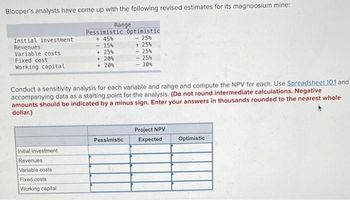
FINANCIAL ACCOUNTING
10th Edition
ISBN: 9781259964947
Author: Libby
Publisher: MCG
expand_more
expand_more
format_list_bulleted
Question
spreadsheet 10.1

Transcribed Image Text:Blooper's analysts have come up with the following revised estimates for its magnoosium mine:
Range
Initial investment
Revenues
Variable costs
Fixed cost
Working capital
Initial investment
Pessimistic Optimistic
+45%
Revenues
Variable costs
Fixed costs
Working capital
- 15%
+ 25%
+ 20%
+ 20%
Conduct a sensitivity analysis for each variable and range and compute the NPV for each. Use Spreadsheet 10.1 and
accompanying data as a starting point for the analysis. (Do not round intermediate calculations. Negative
amounts should be indicated by a minus sign. Enter your answers in thousands rounded to the nearest whole
dollar.)
25%
+ 25%
- 25%
- 25%
30%
Pessimistic
Project NPV
Expected
Optimistic

Transcribed Image Text:A. Inputs
Initial investment ($ thousands)
Salvage value ($ thousands)
Initial revenues ($ thousands)
Variable costs (% of revenues)
Initial fixed costs ($ thousands)
Inflation rate (%)
Discount rate (%)
Receivables (% of sales)
Inventory (% of next year's costs)
Tax rate (%)
B. Fixed assets
Investments in fixed assets
Sales of fixed assets
Cash flow from fixed assets
C. Operating cash flow
Revenues
Variable expenses
Fixed expenses
Depreciation
Pretax profit
Tax
Profit after tax
Operating cash flow
D. Working capital
Working capital
Change in working capital
Cash flow from investment in working capital
E. Project valuation
Total project cash flow
Discount factor
PV of cash flow
Net present value
Year:
10,000
2,000
15,000
40.0%
4,000
5.0%
12.0%
16.7%
15.0%
21.0%
0
10,000
-10,000
1,500
1,500
-1,500
1
15,000
6,000
4,000
2,000
3,000
630
2,370
4,370
4,075
2,575
-2,575
0.408
1,795
0.893
2
15,750 16,538
6,300
6,615
4,200
4,410
2,000
2,000
3,250
3,513
683
738
2,568
4,568
4,279
204
-204
0.408
-11,500
4,364
1.000
0.797
-11,500 1,603 3,479
6,113.1
3
2,775
4,775
4,493
214
-214
0.408
4,561
0.712
3,246
4
17,364
6,946
4,631
2,000
3,788
796
2,993
4,993
4,717
225
-225
0.408
4,768
0.636
3,030
5
18,233
7,293
4,862
2,000
4,078
856
3,221
5,221
3,039
-1,679
1,679
0.250
6,900
0.567
3,915
6
1,580
1,580
0
-3,039
3,039
4,619
0.507
2,340
Expert Solution
This question has been solved!
Explore an expertly crafted, step-by-step solution for a thorough understanding of key concepts.
This is a popular solution
Trending nowThis is a popular solution!
Step by stepSolved in 2 steps with 2 images

Knowledge Booster
Learn more about
Need a deep-dive on the concept behind this application? Look no further. Learn more about this topic, accounting and related others by exploring similar questions and additional content below.Similar questions
- Q#2 Submit this question as one CPP files Write a complete C++ program. In this program you have to write 3 functions in addition to the main function. 1. Function #1: Write function throwDice that generates a random number between 1 and 6. The function should return the generated number. int throwDice(); 1. Function #2: Write function userGuess that asks the user to enter a valid number between 1 and 6. The function should ask the user to re-enter as long as the input is not valid. The function should return the valid input of the user. int userGuess(); 1. Function #3: Write function decide that receives as input parameters two integers, the first parameter dice represents the dice value and the second parameter userG represents a user guess. This function should return true if userG and dice are equal; otherwise, it should return false. bool decide(int dice, int userG); Write a complete program to do the following in the main: 1. Call the function dice. 2. Call the function…arrow_forwardHi can you show how to input in excel using the pmt formula thank you so mucharrow_forwardManaged CDOs is designed for what?arrow_forward
arrow_back_ios
arrow_forward_ios
Recommended textbooks for you

 AccountingAccountingISBN:9781337272094Author:WARREN, Carl S., Reeve, James M., Duchac, Jonathan E.Publisher:Cengage Learning,
AccountingAccountingISBN:9781337272094Author:WARREN, Carl S., Reeve, James M., Duchac, Jonathan E.Publisher:Cengage Learning, Accounting Information SystemsAccountingISBN:9781337619202Author:Hall, James A.Publisher:Cengage Learning,
Accounting Information SystemsAccountingISBN:9781337619202Author:Hall, James A.Publisher:Cengage Learning, Horngren's Cost Accounting: A Managerial Emphasis...AccountingISBN:9780134475585Author:Srikant M. Datar, Madhav V. RajanPublisher:PEARSON
Horngren's Cost Accounting: A Managerial Emphasis...AccountingISBN:9780134475585Author:Srikant M. Datar, Madhav V. RajanPublisher:PEARSON Intermediate AccountingAccountingISBN:9781259722660Author:J. David Spiceland, Mark W. Nelson, Wayne M ThomasPublisher:McGraw-Hill Education
Intermediate AccountingAccountingISBN:9781259722660Author:J. David Spiceland, Mark W. Nelson, Wayne M ThomasPublisher:McGraw-Hill Education Financial and Managerial AccountingAccountingISBN:9781259726705Author:John J Wild, Ken W. Shaw, Barbara Chiappetta Fundamental Accounting PrinciplesPublisher:McGraw-Hill Education
Financial and Managerial AccountingAccountingISBN:9781259726705Author:John J Wild, Ken W. Shaw, Barbara Chiappetta Fundamental Accounting PrinciplesPublisher:McGraw-Hill Education


Accounting
Accounting
ISBN:9781337272094
Author:WARREN, Carl S., Reeve, James M., Duchac, Jonathan E.
Publisher:Cengage Learning,

Accounting Information Systems
Accounting
ISBN:9781337619202
Author:Hall, James A.
Publisher:Cengage Learning,

Horngren's Cost Accounting: A Managerial Emphasis...
Accounting
ISBN:9780134475585
Author:Srikant M. Datar, Madhav V. Rajan
Publisher:PEARSON

Intermediate Accounting
Accounting
ISBN:9781259722660
Author:J. David Spiceland, Mark W. Nelson, Wayne M Thomas
Publisher:McGraw-Hill Education

Financial and Managerial Accounting
Accounting
ISBN:9781259726705
Author:John J Wild, Ken W. Shaw, Barbara Chiappetta Fundamental Accounting Principles
Publisher:McGraw-Hill Education